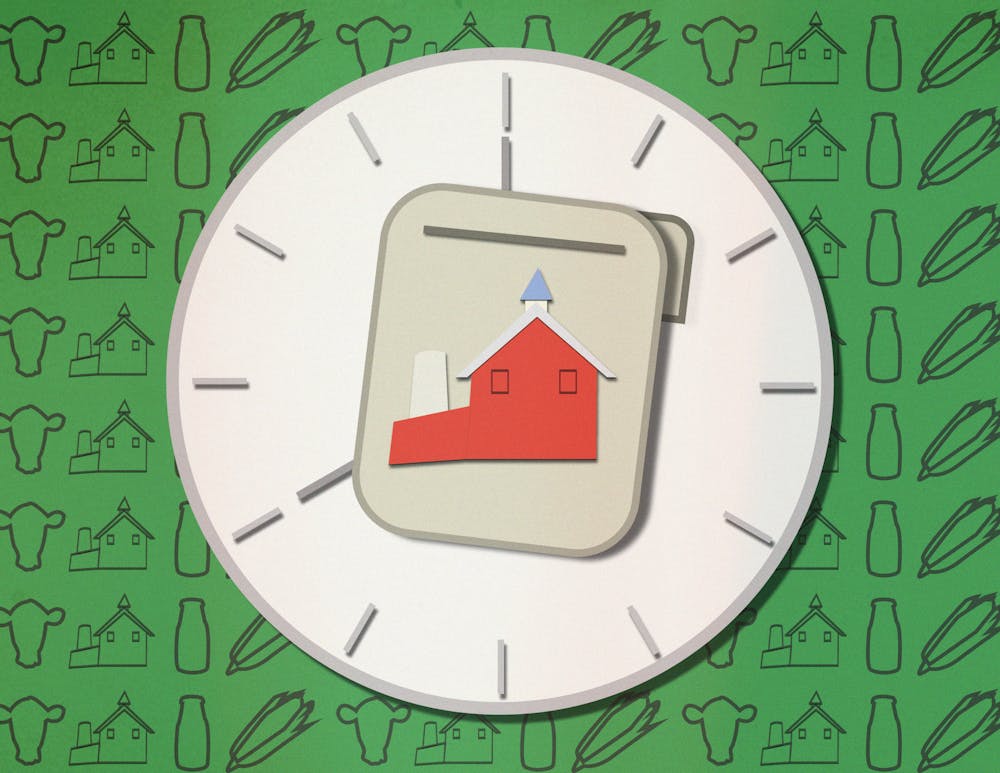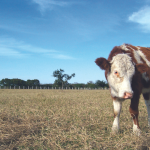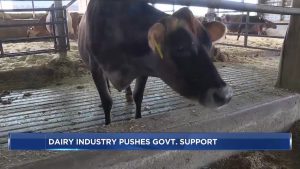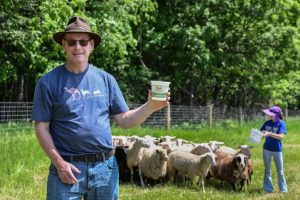
When he’s not studying at the University of Wisconsin-Madison, Jacob Knigge spends his time at his family’s dairy farm nestled in the rolling fields of Omro, Wisconsin. At Knigge Farms, he spends the day on field work — feeding cows and calves, scraping stalls and laying down fresh bedding.
“I really like working with the cows because they all have their own personalities,” Knigge told The Daily Cardinal.
In the past decade, Knigge said he’s noticed a worrying trend.
“We used to have over five farms within a seven- or eight-minute drive from us, and now there’s only one other one besides us,” Knigge said.
For Wisconsin, a state that holds a quarter of the nation’s total dairy farms and has experienced numerous bankruptcies and closures, congressional delays toward a new farm bill have farmers wondering when a modern version of the omnibus will be in season.
The omnibus farm bill, a sweeping legislative package which provides nutritional assistance and farming subsidies, must be reauthorized every five years and was last updated in 2018.
Although it was slated for renewal in 2023, Republican House leadership battles and appropriations struggles led to a continuing resolution for the 2018 farm bill rather than an updated package.
“If we don’t get a bill done, we’re constantly going to deal with this hanging over our head, going back to decades-old law around milk pricing that negatively affects us,” House Appropriations Committee member Rep. Mark Pocan, D-Wisconsin, told the Cardinal.
Still, some lawmakers in the Republican caucus have concerns about how specific programs in the package — nutritional assistance and conservation chief among them — will be administered.
Once U.S. Rep. Mike Gallagher, R-Wis., resigns on April 19, the narrow majority of four Republicans in the House means two Republicans could sink the package if no Democrats supported it.
“All they need are a smaller amount of people to screw up the process, and unfortunately, they’ve had a lot of people doing that along the way,” Pocan said.
But waiting, particularly in struggling sectors like dairy, isn’t an option, farmers cautioned.
“We’re looking at a number of farms that go out of business, and the vast majority of them are going out of business because they can’t pay the bills at the end of the month,” Darin Von Ruden, Wisconsin Farmers Union president, told the Cardinal.
How is the bill passed, and what does it do?
Despite its name, the farm bill provides assistance to people far beyond farmers, like people seeking nutritional assistance.
“Some food advocates have suggested we call it a food bill instead of a farm bill. The title is a little confusing because most of the aid is not about farms,” said Jeffrey Filipiak, a UW-Oshkosh environmental science professor.
The largest of the 2018 bill’s 12 titles, nutrition assistance, made up 76% of the package’s expenditures and covers programs like the Supplemental Nutrition Assistance Program (SNAP). The three next-largest titles are crop insurance, commodities and conservation, which provide premium subsidies, price and income support for dairy, sugar and high-demand non-perishable crops as well as conservation programs for farmers.
Some programs in the bill, like SNAP, are guaranteed funding in the appropriations process, controlled by appropriations committees in the House and Senate that examine budget requests and create budget bills. But others are allocated amounts through discretionary spending, meaning their funds are optional and must be reapproved by Congress each year.
A Wisconsin Republican, Rep. Derrick Van Orden, sits on the House Agriculture Committee which will create the package alongside its corresponding committee in the Senate. A spokesperson for Van Orden did not respond to interview requests.
Von Ruden said Van Orden expressed “some differences” in belief with Wisconsin Farmers Union members and said their views “haven’t quite gotten through to him.”
“It’s a little concerning because it seems like he would much rather see cuts to the nutrition title of the farm bill,” Von Ruden said, adding that Van Orden was also looking at “overall cuts” to the budget.
It’s in that last stage where the greatest challenge lies: in case of a party-line floor vote on the package, razor-thin majorities in the House Republican caucus mean just two members could break from the majority to sink it.
Pocan said he’s been told the agricultural funding package approved on March 6 could “solve some of the stickier issues,” particularly with SNAP.
But the House Republican caucus’ tight control over what legislation passes left Von Ruden and Pocan uncertain about the prospects of a new bill this year.
“[Former House Speaker Kevin McCarthy] made it so that any handful — literally — of members could cause havoc and kill bills. That’s not the way it’s intended,” Pocan said. “Out of 435 people, you shouldn’t have four or five be able to stop the entire process.”
Nutrition, conservation titles at center of debates
The prospect of potentially changing SNAP eligibility is creating contention in farm bill talks. Though Van Orden said he supports SNAP as a “hand up,” he’s been noncommittal on potential expansions to existing work requirements and voiced concerns on potential fraud within the system.
Increased work requirements tend to make the programs less efficient due to money spent on overhead and processing and could affect people who need the aid the most, Filipiak said.
“Maybe they aren’t fluent in English, so they have trouble filling out the application form. Or maybe they just get frustrated and stop applying so that you get aid to fewer people who deserve it,” Filipiak said.
Changes to SNAP eligibility would also disproportionately affect people of color, who experience higher rates of food insecurity.
Though Wisconsin has a below-average rate of food insecurity, it has among the largest disparities between Black and white households in the nation — 7.4% of white households in Wisconsin were food insecure between 2015 and 2019, compared to 32.6% of Black households, according to UW-Madison’s Wisconsin Food Security Project.
Reforms to SNAP administration could also change student regulations like stringent exemption requirements, which make it tougher for students to qualify.
Alongside nutrition, the conservation title has been subject to heated debate as advocates aim to reduce agricultural contributions to the climate crisis.
Programs in the title encourage farmers to use sustainable practices in their agriculture through subsidies and grants. In fiscal year 2023, Wisconsin received 4,452 total applicants for two conservation programs supercharged by funding from the Inflation Reduction Act — the Environmental Quality Incentives Program and Conservation Stewardship Programs — though only 1,787 applicants were awarded contracts.
Von Ruden said taking care of land through the high-demand programs is necessary for economic stability and food availability. He said he wants to see more conservation funding, not less.
Yet potential cuts or clawbacks to the conservation and nutrition titles, including repurposing the IRA funds currently used in the conservation title, were at the center of heated debate between Democrats and Republicans on the House and Senate Agriculture Committees, according to POLITICO.
Consolidation has farmers union president hoping for ‘competition’ title
One of the farmers union’s asks is a “competition” title to allow greater numbers of buyers for more competitive sales to processors. Decentralizing market power is one of Von Ruden’s biggest hopes, he said.
“The numbers of processing facilities has been shrinking, and then also the number of owners in that system have really been decreasing,” Von Ruden said. “We’ve got fewer and fewer places that we can actually sell our milk into or our beef into.”
Though the number of Wisconsin farms has decreased 10% since 2017, the farms that stick around are getting larger. The average size of a Wisconsin farm was 236 acres, according to 2022 census data from the U.S. Department of Agriculture, the largest it’s been in more than two decades.
A 2024 Department of Agriculture report found 88% of U.S. farms are small family farms, but the families running them usually rely on off-farm sources for a majority of their household income. Large family farms were about 3% of farms and account for nearly 52% of production value, according to the report.
Dairy pricing just one of the uncertainties facing Wisconsin
Von Ruden echoed Pocan’s criticism of “decades-old” dairy prices, which he said don’t reflect the current costs of producing dairy.
Farmers are “price-takers” and not price-setters, Von Ruden said, meaning consolidation in retail and processing industries allows processors to demand lower prices from farmers.
“We need to see a different pricing structure within the dairy industry to allow farmers to recover more of those costs from the consumer dollar,” Von Ruden said. “The middleman is just taking a bigger share of the consumer dollar and the farmer receives a smaller share on a regular basis.”
Changes to pricing structures are just one of many uncertainties facing farmers like Knigge, who said his family considers available subsidies while planning crop harvests for coming years.
Though large farmers are more likely to consider farm bill changes in their planning processes, Von Ruden said, having certainty in a passed bill would help farmers plan their futures.
“Looking at what’s going on in D.C. right now, I’m not sure that they’re gonna get a farm bill signed this year,” Von Ruden said.
And while Pocan hopes the appropriations package will help speed the process along, getting a full farm bill passed will be harder, he said.
“This Congress in general just has difficulty being itself,” Pocan said.
You can now read the most important #news on #eDairyNews #Whatsapp channels!!!
🇺🇸 eDairy News INGLÊS: https://whatsapp.com/channel/0029VaKsjzGDTkJyIN6hcP1K
























